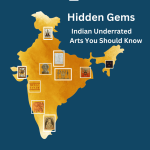
India’s art scene is a dazzling mosaic, where countless regional art forms come together to create a vibrant tapestry. Each form boasts its own unique style, stories, and traditions, passed down through generations. Today, we embark on a captivating journey to discover some of India’s hidden artistic gems. From intricate paintings to captivating sculptures, these art forms offer a glimpse into the soul of India’s diverse culture and heritage. So, join us as we delve into the artistic treasures waiting to be unearthed across various Indian states!




